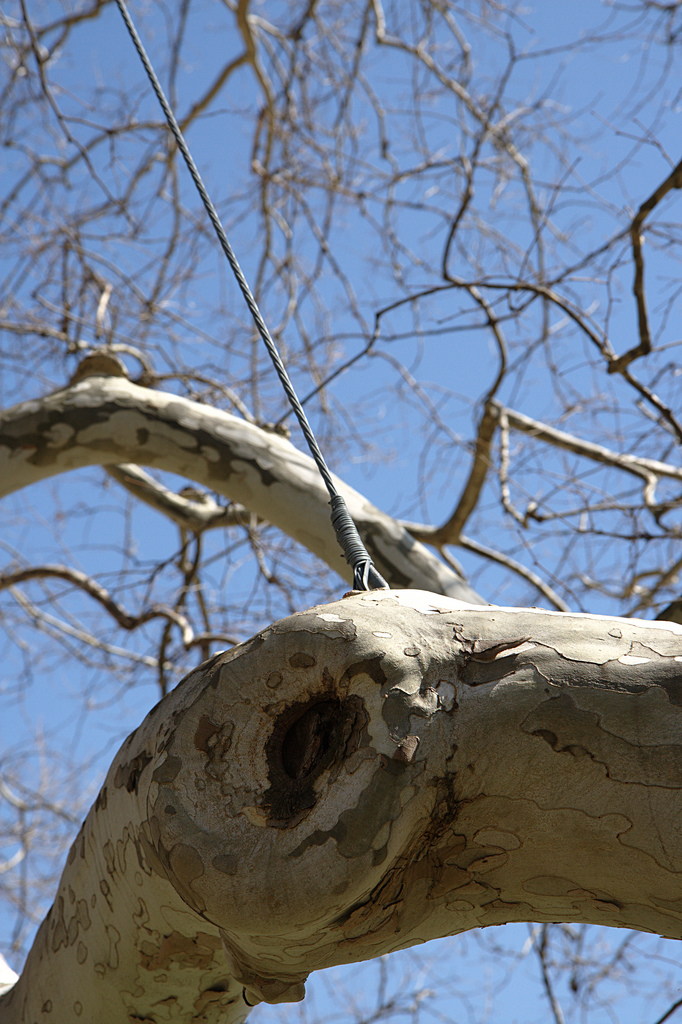
This is the first half of a two part series on cabling and bracing. This article will focus on cabling, and what this support method entails.
As trees age, they grow and develop, increasing in size and complexity. Trees that experience significant growth can become more susceptible to structural weaknesses, and wounding. This can impact the integrity of a tree, resulting in its decline, and potential failure. Proper structural pruning, and routine maintenance help support trees as they grow, preventing the development of codominant leaders, and branches with narrow v-shaped crotches. Proper pruning also assures correct limb distribution among a tree’s branches and stems, providing the tree with appropriate shape, and balance. But there are occasions when pruning alone is not enough to sustain the health of a tree, and the installation of a cable or bracing rod becomes necessary.
The practice of installing a cable or bracing rod in a tree is referred to as cabling and bracing. Cables and bracing rods act as supplemental support systems for trees or limbs that are structurally unsound. When installed correctly, cables and bracing rods help to maintain crown stability in trees, and provide support for weak branch crotches and limbs, thereby reducing the risk of limb, leader, or whole tree failure. Cabling and bracing can be used in tandem, but each practice represents a different support method, and is used for distinct purposes.
What Is Cabling?
Cabling is the installation of one or more flexible steel cables between tree limbs. It is often performed to limit excessive movement of weakly connected limbs, and to provide support for split or decayed crotches, and crotches with included bark. It can also help stabilize heavier horizontal limbs by connecting two or more limbs together.
Types of Cable:
There are two major types of steel cable used in cabling: common grade seven-strand galvanized cable, and extra high strength cable (EHS). Seven-strand cable is more flexible; its malleability makes it easier to work with. Extra high strength cable is stronger, but not as easily manipulated.
Types of Cabling Systems:
Each type of cable is installed using one of two cable systems: simple-direct, or triangular. Simple-direct systems are used to provide lateral support to weak crotches or long, horizontal branches. They are also recommended for branch crotches that contain included bark. In a simple-direct system, one cable is installed between two leaders, or between a horizontal branch and the trunk of the tree. Simple-direct systems are generally used when there is no third leader or branch that would allow for the installation of a triangular system. Simple-direct systems provide support in only one direction, and do not prevent torsional twisting. Triangular systems provide cables to at least three different leaders, or branches. Each leader or branch is supported in two directions, minimizing torsional twisting, and providing lateral support to weak crotches.
Proper Cable Installation
The condition of a tree determines whether or not cabling is warranted. If a tree has a weak root system, or contains widespread decay, removal is preferable, as cabling will not offset such structural deficiencies. If cabling is necessary, pruning is required prior to the installation in order to remove any hazardous limbs or deadwood that may be present in the tree. Pruning can also be used to help reduce the weight of the leader or branch that is to be cabled. Do not remove any old cabling systems until the new one is in place, and if multiple cables are to be installed, they should be separated by at least twelve inches, with each cable attached to its own anchor.
Anchors should never be installed in limbs that contain extensive decay, as it can weaken the cable’s attachment, and cause the limb to fail. Cables should be installed safely away from any other limbs, or objects present in the tree. If the tree contains a lightning protection system, the cable should be attached to it using the appropriate connectors. Cables should also never be installed in any trees that are rooted closely to utility lines, or have utility lines passing through them.
Even after they have been installed, cables should be inspected periodically in order to ensure their efficacy, and safety. Examine the area of the tree where the cable is attached for any cracks, or signs of decay. Also inspect any cable for corrosion or degradation in the steel.
Ultimately, cables, even when reinforced with bracing rods, are limited in their capabilities. They can provide support for a limb, or leader, but they cannot always be relied upon to make a hazardous tree safe.
Beige Alert / Foter / CC BY


